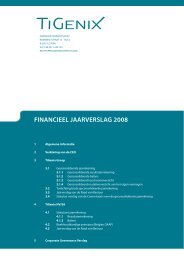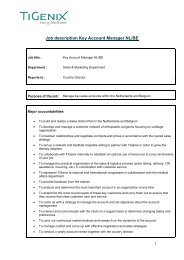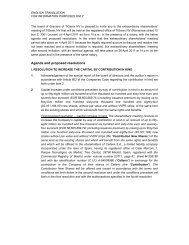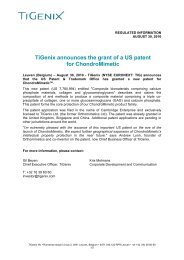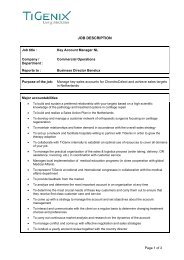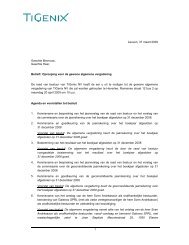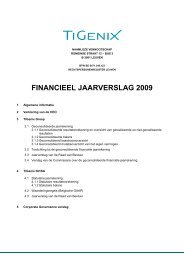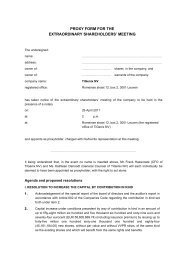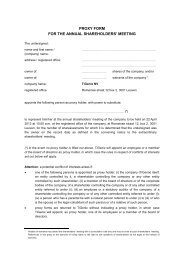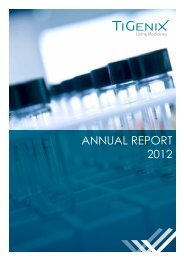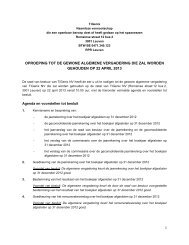ANNUAL FINANCIAL REPORT 2010 2010 - TiGenix
ANNUAL FINANCIAL REPORT 2010 2010 - TiGenix
ANNUAL FINANCIAL REPORT 2010 2010 - TiGenix
- No tags were found...
Create successful ePaper yourself
Turn your PDF publications into a flip-book with our unique Google optimized e-Paper software.
The Company cannot predict what effect subsequent changesin European, Belgian or Spanish legislation or regulations mayhave on the Company’s business.<strong>TiGenix</strong> relies or may rely on third partiesfor certain of its research, clinical trials,technology, supplies, manufacturing and salesand marketing. <strong>TiGenix</strong>’ dependence on thirdparties may reduce its profit margins and delayor limit its ability to develop and commercialiseits products on a timely and competitive basis.The Company has entered into agreements and arrangementswith a number of third parties and may enter into additionalagreements and arrangements for research, clinical trials,technology, manufacturing, supplies, and sales and marketing.The Company relies primarily on third party contractresearch organisations to conduct its clinical trials. As a result,<strong>TiGenix</strong> does not have, and will not have in the future, fullcontrol over the conduct of the clinical trials, the timing andcompletion of the trials, the required reporting of adverseevents and the management of data developed throughthe trials. Communicating with outside parties can alsobe challenging, potentially leading to mistakes as well asdifficulties in co-ordinating activities. Outside parties mayhave staffing difficulties, may undergo changes in priorities ormay become financially distressed, adversely affecting theirwillingness or ability to conduct the Company’s trials. <strong>TiGenix</strong>may experience unexpected cost increases that are beyondits control. Problems with the timeliness or quality of the workof a contract research organisation may oblige the Companyto seek to terminate the relationship and use an alternativeservice provider. However, making this change may be costlyand may delay the Company’s trials, and contractual restrictionsmay make such a change difficult or impossible. Additionally, itmay be impossible to find a replacement organisation that canconduct the Company’s trials in an acceptable manner and atan acceptable cost.While there are numerous suppliers on the market for mostof the supplies that <strong>TiGenix</strong> needs for its activities, there is nocertainty that the current suppliers will continue to supply theirproducts under commercially viable terms, in accordance withthe applicable regulations or in compliance with the obligatoryproduction standards in the countries where <strong>TiGenix</strong> expects tosell its products, which may mean that <strong>TiGenix</strong> could be forcedto seek alternate suppliers. <strong>TiGenix</strong> also faces the risk that itssuppliers are unable to provide the necessary quantities andqualities needed to satisfy the Company’s and the market’sdemands. There are two production materials (foetal bovineserum from Australia and New Zealand for culturing cells andcertain cell culturing containers) for the supply of which <strong>TiGenix</strong>currently depends on a particular supplier.The materialisation of some of these risks could cause delaysin the commercialisation or the development of <strong>TiGenix</strong>’ eASCbased products.As is currently already the case for the manufacturing andpackaging of ChondroMimetic, <strong>TiGenix</strong> may in the futurerely on a number of contract manufacturing organisations todevelop and manufacture certain of its products, includingfor its clinical development programmes. There can be noguarantee that <strong>TiGenix</strong> will be successful in establishingsuch manufacturing arrangements on acceptable terms,or at all, or in maintaining those. There is a risk that if one ofthese organisations were to cease supplying products for<strong>TiGenix</strong> there would be a delay in, and an increase in thecosts of, its product development programmes. There can beno assurance that <strong>TiGenix</strong>’ products, including its currentlyunapproved products, if approved, can be manufactured insufficient commercial quantities, in compliance with regulatoryrequirements and at an acceptable cost.The Company may further expand its activities in the futureby in-licensing certain technologies and/or products andby acquisitions. Collaboration and integration will have animportant impact on the success of the Company’s expansionstrategy.<strong>TiGenix</strong> may not own the patents or supplementaryprotection certificates on the basis of which these licencesmay be granted. These licenses may generally be terminatedby the licensor in the event of certain breaches by <strong>TiGenix</strong>of its obligations under the license and in other specifiedcircumstances. If any of the Company’s license agreements isterminated, the further development and commercialisationof some of the development products could be prevented ordelayed, reducing its potential revenues. The scope of <strong>TiGenix</strong>’rights under its licences may be subject to dispute by licensorsor third parties. <strong>TiGenix</strong> generally does not control the filingor the prosecution of the patents to which it holds licencesand it is relying upon its licensors to enforce the patents andto prevent and/or to challenge possible infringement by thirdparties. There can be no assurance that the Company will beable to obtain licences for the technologies that it requires inthe future.29 •



